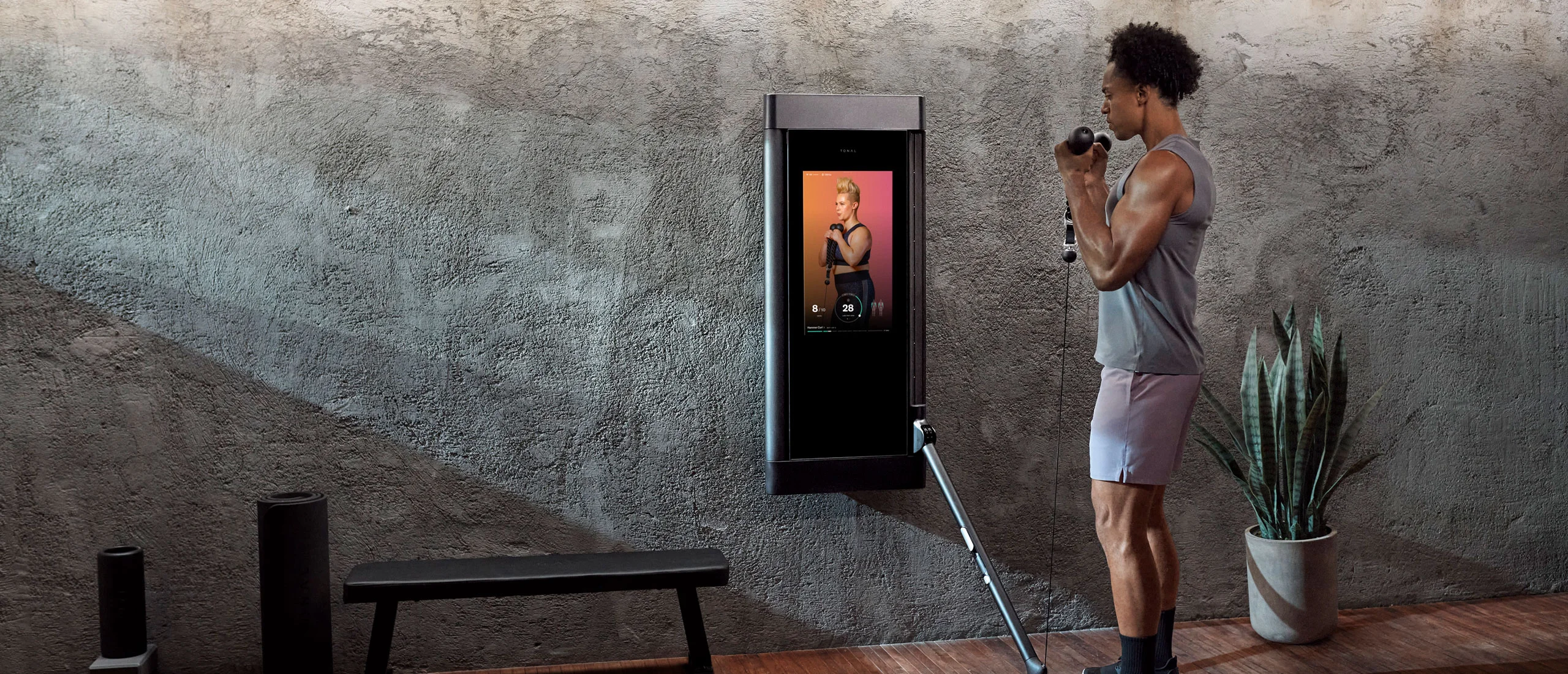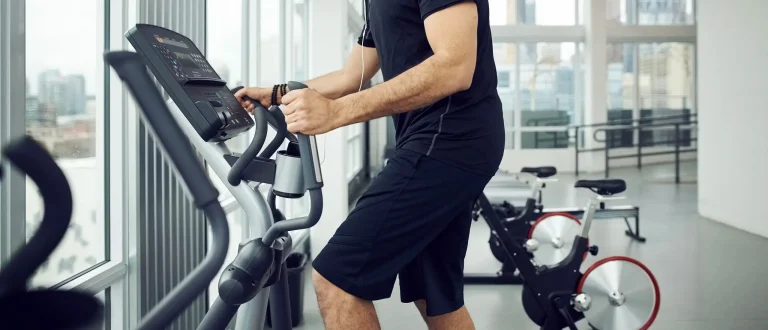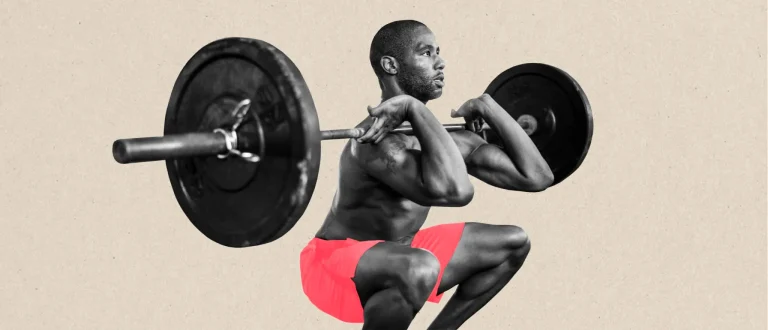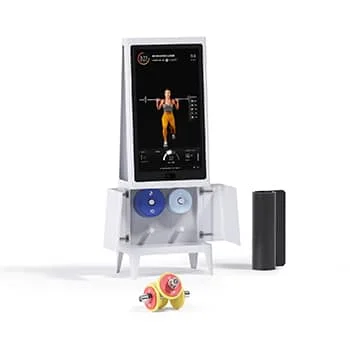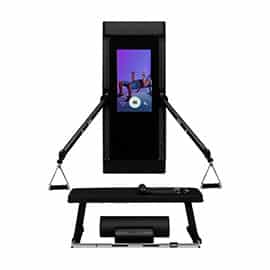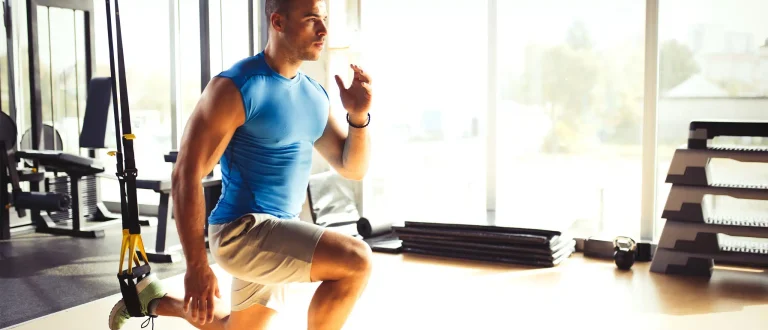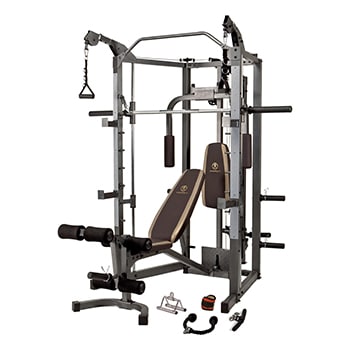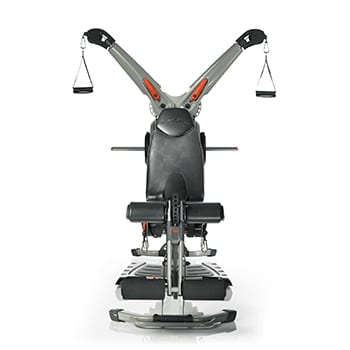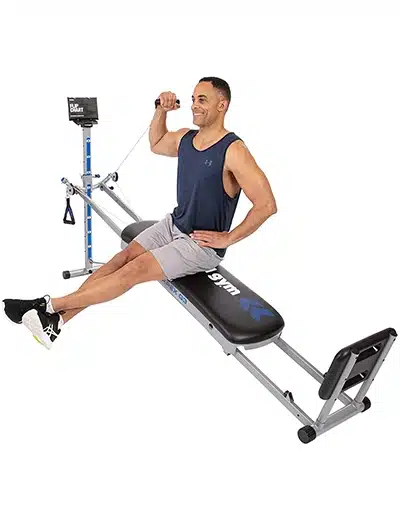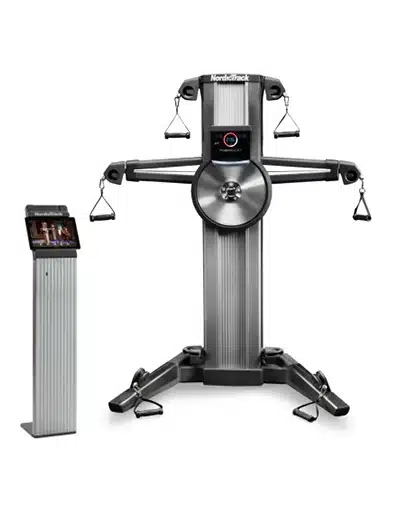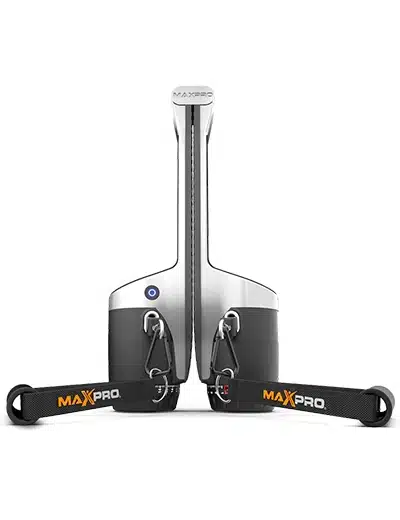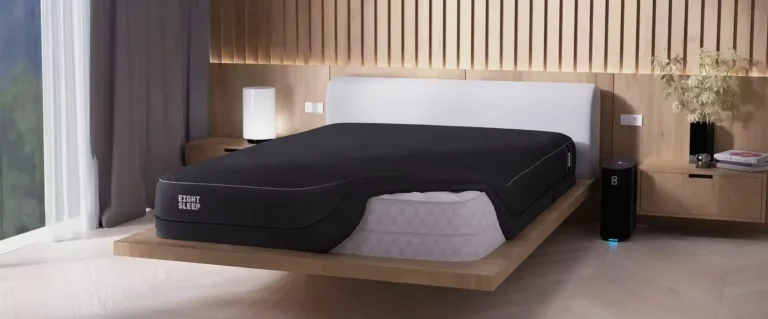Our product recommendations are selected by editors, tested first-hand, or expert-approved. We may earn a commission through links on our site.
There are plenty of perks to building an at-home gym. Not only is it great for saving time and money, but it allows you to build a workout space that includes everything you love about the gym—and cut out everything you don’t (like the guy who never wipes his sweat off of anything). And while it can be rewarding to build a gym with several different pieces of equipment (we’re big fans of adjustable dumbbells), there’s something extra convenient about making one big purchase to satisfy all of your workout needs. And for that, we present to you this list of our ten favorite workout machines—from home gym systems with AI technology to classic heavy cable machines to a home gym that easily fits inside a suitcase, we’ve got an option for your fitness, budget, and space needs.
Is There a “Best” Home Gym Machine?
No, but there may be a “best for what you need” home gym machine. The best option for you will be the one that best addresses your needs. First, identify what key features you want in a home gym machine. Doing so will narrow down the list significantly.
What to Consider for in a Gym Machine
Virtual classes
The presence or absence of a virtual trainers, classes, and group exercises are relatively new features to consider when shopping for an all-in-one home fitness setup. With very few exceptions, these service-driven gym machines are more expensive than the traditional multi-gym setups that typically take the shape of combo Smith machines or cable crossovers.
Real estate
How much space do you have? Smith machines and cable crossover setup eat up significant chunks of space. This Marcy brand version is roughly 8 feet by 5 feet when assembled, and you can add at least another foot onto those measurements to guarantee safe clearance.
Newer products like Tonal, Mirror, and Tempo are more mindful of the footprint in a home, but, as mentioned earlier, you do pay for it.
Wall sturdiness
Not all, but some machines require fastening to or leaning up against a wall. There’s not anything inherently wrong with this, but it does increase risk of damage. Consider padding on the wall behind your machine, and make sure the wall you intend to use is in good condition before putting it under stress.
Upfront cost vs. cost over time
Subscription-based machines have become commonplace with the rise of virtual class-driven products. You pay for the product, then you pay for what the product does. It’s necessary to fold the upfront cost of the product in with the monthly cost of the product’s subscription service. You can use most of the subscription-minded products without a subscription, but it’s a bit like getting a Peloton and not the screen that comes with it.
Also, it’s worth mentioning the inherent risk with investing in fundamentally tech-driven fitness gear: if the people behind the tech fall, so does your machine. This could take the form of slow updates, updates that don’t work, or the company going kaput.
Workout More
The Best Weight Machines on the Market
Tempo Studio Starter Pack
The Tempo Studio is a great combination of impressive technology and more simplistic, classic resistance training. For looks, the system has a sleek, A-frame design—the top boasts a 42-inch screen, and the bottom a shelf for storing included resistance bands, collapsable barbells and weight plates. But what really makes the Tempo Studio special is the real-time feedback it provides on form and performance via 3-D cameras and AI technology. There are also hundreds of different classes, ranging from classic strength training to yoga and HIIT workouts. For users who love their group fitness classes, there are live workouts available on the platform that allow instructors to provide feedback to participants in the moment. One con, however, is the low number of weight options, making it a poor choice for those who are looking to lift heavy (in the most basic package, all the weight plates combined are 75 pounds).
The bottom line: This is a great option for those who love group fitness, don’t have a need to regularly lift super heavy, want to use more classic fitness modalities like dumbbells, barbells, and resistance bands, and are looking for safe, real-time feedback on their workouts.
NordicTrack Vault Complete
The Nordictrack Vault is essentially a large five-tiered shelf with a 61.5-inch touch-screen monitor that doubles as a functional mirror with built-in iFit, Nordictrack’s fitness platform that includes hundreds of different workouts ranging from yoga to strength training and beyond. (Note: purchase of the Vault includes a year subscription to iFit, and after that, it’s $39 per month). The list of included workout equipment in the more expensive “Complete” option is impressive: six sets of dumbbells ranging from 5 to 30 pounds, two kettlebells (20 and 30 pounds, six different resistance bands (including heavy resistance bands), a mat, yoga blocks, and even a microfiber cleaning towel. The internal shelving system is designed to hold all of this equipment as well, which makes it great for saving space. The system is also available for purchase without the equipment for anyone who already has some of their own.
The bottom line: The Nordictrack Vault ideal for smaller spaces, is multi-functional when not in active use, takes the guesswork out of building at-home workouts with iFit, and includes a large variety of traditional exercise equipment. However, it doesn’t give the real-time feedback that some of its competitors do.
Mirror Pro
Going on aesthetics alone, the Mirror is one of the best options on this list. The system is barely distinguishable from a regular wall-mounted mirror when not in use, making it an incredible option for anyone who is really limited on space. It’s also relatively light and portable at 70 pounds, so it can be moved from room to room quite easily. The Mirror is equipped with a front-facing camera, which allows virtual instructors to provide live feedback on form during personal training sessions or live classes. Mirror’s workout platform gives users access to thousands of different workouts, including both live and on-demand, and also has a feature that allows users to virtually work out with friends. However, Mirror is very much a cardio-based concept compared to others and relies on users to mostly utilize their own equipment for strength workouts. The Pro system does include a set of resistance bands, a heart rate monitor, a set of dumbbells (a choice of dumbbells ranging from 1 to 35 pounds), yoga blocks, a mat, and a few other accessories, but it’s still pretty limited compared to some competitors.
The bottom line: This is an attractive-looking, space-saving option for anyone who enjoys bodyweight and/or cardio training, or someone who already has access to a variety of strength-training equipment. This is not a great option for those who are looking for a system that has a lot of opportunities for resistance training built-in.
Tonal
Tonal is having a moment in the fitness world. Currently backed by the likes of big-name athletes such as Serena Williams and Stephen Curry, Tonal is probably the smartest weight machine on this list. At its core, it’s a wall-mounted system that, like many at-home gyms, utilizes a cable pulley system. But that’s about where the similarities end. Tonal is designed to provide a very individualized and intentional user experience, conducting an initial full-body strength assessment and, using AI, adjusting resistance for every single workout based on the individual. Tonal takes the guesswork out of selecting weights, keeps track of reps, and provides real-time feedback on form utilizing 17 built-in sensors. All you have to do is adjust the handles, with guidance provided by the screen. Tonal has a large library of workouts and even has live classes that allow for real-time feedback from actual coaches.Tonal does have some negatives that are important to consider. One, it has a very expensive up-front cost, and on top of that, requires a minimum year-long subscription to its workout platform (which is $49 per month). It also has a maximum resistance of 200 pounds (100 per arm). It has to be professionally installed (and re-installed if you move) and requires seven feet of space on all sides, which makes it difficult to fit in smaller spaces. It also doesn’t include several accessories, like a bench and different handles, which are all extras you’d need to purchase to be able to do all the workouts.
The bottom line: Tonal is a very high-tech machine. It’s smart and intentional with its workout programming, extremely user-friendly, great for a large range of experience levels, and its technology is simply on another level compared to its competitors. However, it’s a huge up-front cost, and considering it’s entirely based on a cable pulley system, wouldn’t work well for those who really enjoy using free weights.
Recover Faster
Marcy Combo Smith Machine
The Marcy Combo Smith Machine is a great option if you have the space. It includes both an upper and lower cable pulley system for targeting a range of muscle groups, a removable and adjustable bench, a barbell, and a pull-up bar. Compared to some of the more tech-heavy options, this one is a bit more affordable, but it doesn’t include weight plates for the barbell, and a decent set of those can cost another $700 or more. Another con is the amount of space it takes up (seven feet tall, eight feet long, and nearly five feet deep), and its whopping 289-pound weight.
The bottom line: The Marcy Combo Smith Machine is an excellent option for those who want to do regular heavy resistance training with a variety of options. This is also the only weight machine on this list with a pull-up bar. Cons: It takes up a lot of space, and doesn’t provide any guidance on building workouts or correcting form, making it better suited for experienced lifters. It also doesn’t include any plates for the barbell, which can get costly.
Bowflex Revolution Home Gym
You can’t talk about home gyms without talking about Bowflex. The Revolution indeed lives up to the Bowflex name, utilizing a unique system of specialized plates for making weighted adjustments to its cable pulley system. Instead of using a pin system for adjusting weights like similar machines, the Revolution uses special resistance packs that weigh just a few pounds, but once clipped in, can add anywhere from 5 to 40 pounds of resistance. This is thanks to the built-in Spiraflex technology within each pack, which, fun fact, was also utilized by NASA astronauts in space to maintain muscle mass in the absence of gravity. The system itself utilizes two arms that, in combination with the adjustable seat, can accommodate 100 different exercises. Overall, the system can provide up to 220 pounds of resistance for any given exercise, and up to 80 pounds of additional resistance can be purchased separately.
The bottom line: This is a top-of-the-line cable pulley system that includes a comprehensive user guide for learning different movements. It does not provide flexibility of movements beyond cable exercises, but with that said, the adjustability of the machine and the range of resistance allow for plenty of high-quality strength training exercises.
Total Gym APEX
The Total Gym APEX is a weight machine that has been loved by home gym owners since the 1970s. It has stood the test of time for a reason—the simple, yet effective system utilizes a slanted slide board (with options to change the angle) and a user’s own bodyweight for resistance. Plus, it folds up for easy storage. It’s certainly missing some bells and whistles compared to other options on this list, but people love the ease of use, the variety of exercises (it includes a library of 80 different exercises that target all of the major muscle groups), and the fact thatthere’s nothing quite like a classic.
The bottom line: The Total Gym APEX has been a go-to home gym option for decades, and is great for anyone looking for a budget-friendly system that’s pretty easy to use. However, for anyone who likes to lift heavy, wants to perform more traditional strength-training movements, or wants a system that provides more guidance and feedback on workouts, there are more fitting options on this list.
NordicTrack Fusion CST
The Nordictrack Fusion CST is a cable system that is unique to others on this list for a couple of reasons. First, it’s compatible with the iFit workout platform, which provides access to hundreds of trainer-led workouts ranging from cardio and HIIT to more traditional strength training. Second, it has six different cables, which are all non-adjustable—that could be a good thing because it takes the guesswork out of adjusting cable heights, but it can be a con for anyone who wants to make more individual adjustments. Third, it utilizes magnetic resistance instead of pins and plates, making it very easy to change up the resistance on the fly, and provides a very smooth feeling during workouts.
The bottom line: This is a very user-friendly cable system that is compatible with iFit, which provides a really good variety of workouts. While there are better space-saving options on this list, the Fusion CST is a great weight machine for beginners and for anyone looking for additional guidance and workout variety from a cable system.
Max Pro SmartConnect
The MaxPro SmartConnect Portable Cable Machine might be the most unique option on this list, as well as the lightest and most compact. This little thing can provide up to 300 pounds of concentric resistance, weighs less than ten pounds, and can fit in a suitcase. For its small size, however, it’s decently expensive. Alone, the system costs just under $800, and purchasing the “elite” pack (which includes extras like a wall mount and bench) will just about double that price. As mentioned before, this machine provides 300 pounds of concentric resistance—think of that as the “shortening” part of a given muscle. But it doesn’t provide any eccentric resistance (the lengthening part), which actually produces more force in muscle movements. Think of doing a bicep curl: Performing one on this machine would involve standing on the machine and curling up. The resistance would be felt while performing the bicep curl, or bending the elbow, but the resistance would completely disappear as soon as the movement was complete and the handle started moving back down towards the machine (or as the elbow extended).
The bottom line: There is no other option that is even close to as mobile and compact as this. It’s an ideal option for frequent travelers or someone who is really crunched for space. It also provides the largest amount of concentric resistance of any cable pulley system on this list. However, it is pretty expensive for the size (although a steal when comparing cost per pound of resistance), and lacks eccentric resistance.

